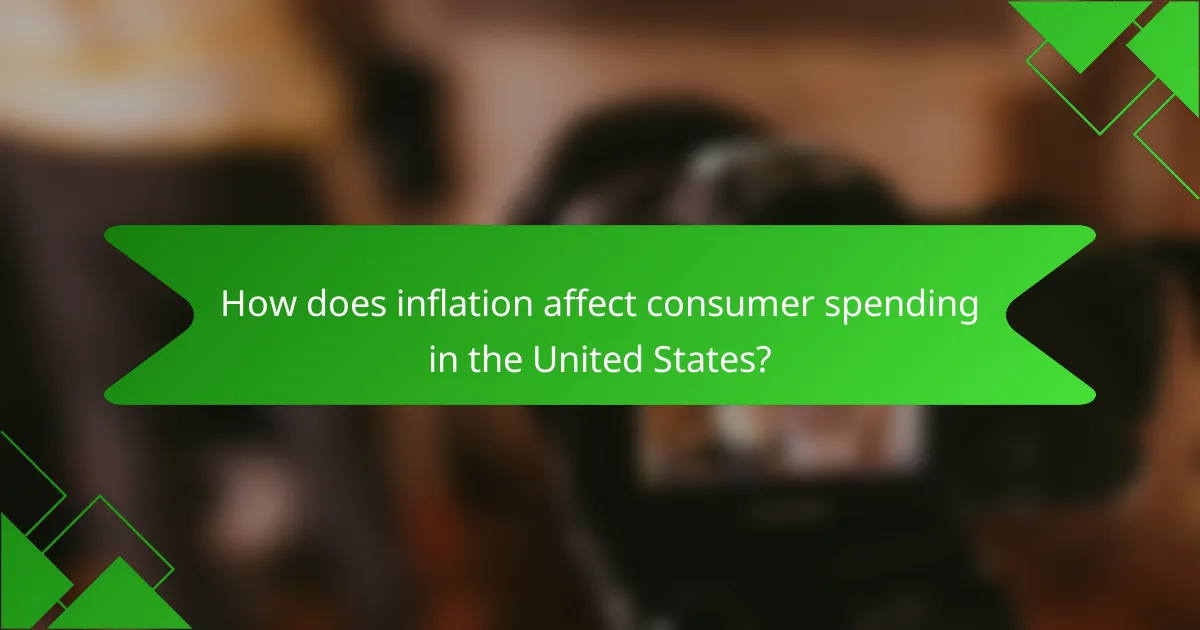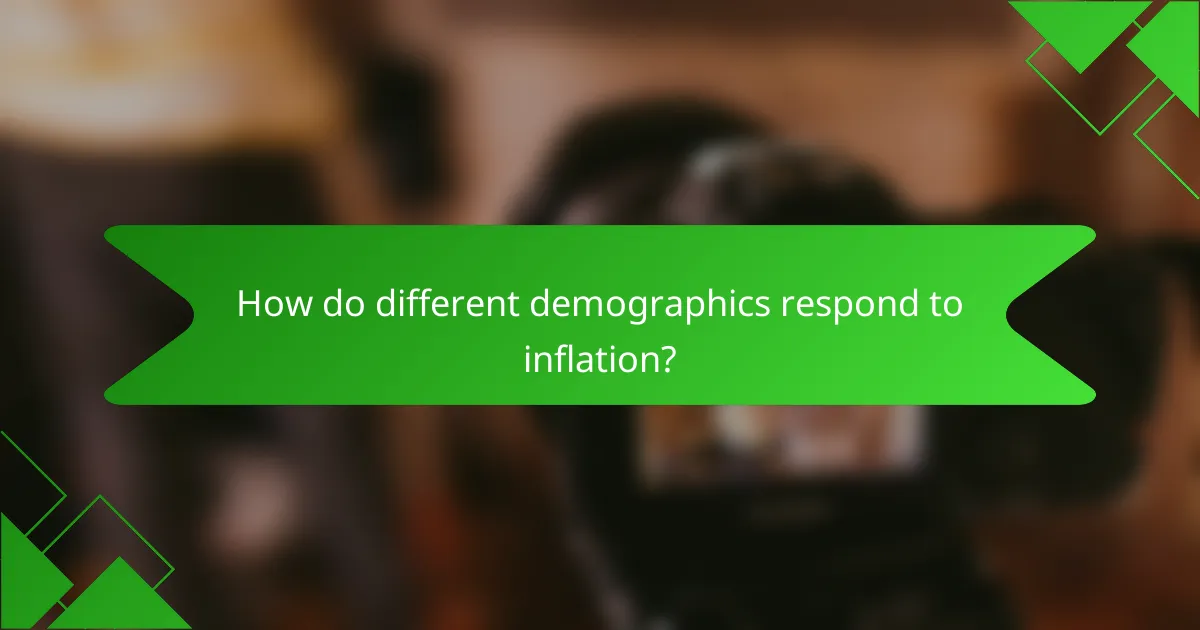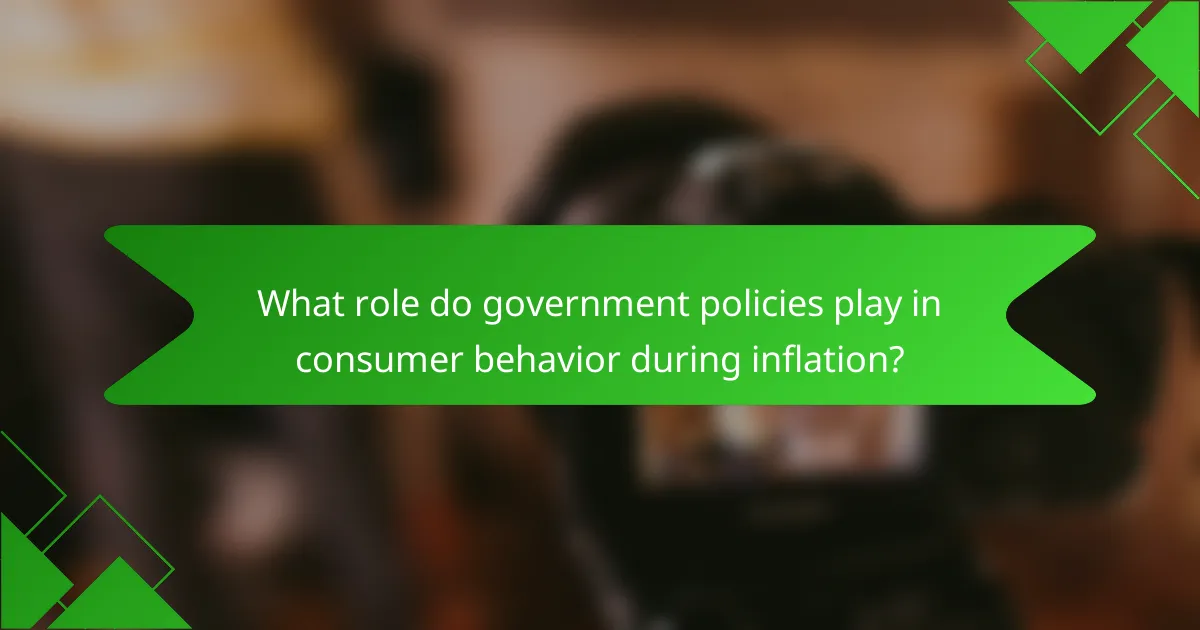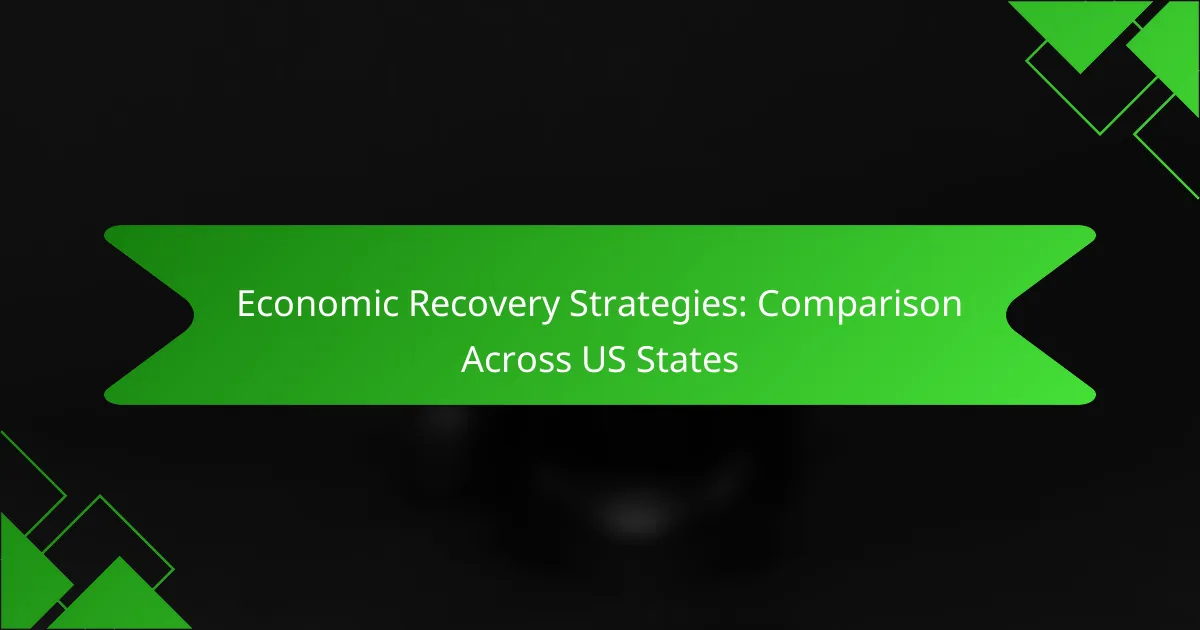Inflation plays a crucial role in shaping consumer behavior by diminishing purchasing power and prompting adjustments in spending habits. As prices increase, individuals often reassess their budgets and prioritize essential purchases, which can lead to a shift towards more cost-effective alternatives. This economic uncertainty can also erode consumer confidence, further influencing how and where people choose to spend their money.

How does inflation affect consumer spending in the United States?
Inflation significantly impacts consumer spending in the United States by eroding purchasing power and altering spending habits. As prices rise, consumers often adjust their budgets, leading to changes in where and how they spend their money.
Increased prices lead to reduced purchasing power
As inflation drives prices higher, consumers find that their money buys less than before. This reduction in purchasing power forces individuals to reconsider their spending habits, often leading to a decline in overall consumption.
For example, if the price of essential goods like groceries and gas rises by 5-10%, consumers may cut back on discretionary spending, such as dining out or entertainment, to accommodate these increased costs.
Shift towards discount retailers
In response to rising prices, many consumers turn to discount retailers and budget-friendly options. This shift reflects a desire to stretch their budgets further while still meeting their needs.
Retailers like Walmart and Dollar Tree often see increased foot traffic during inflationary periods, as consumers seek lower prices on everyday items. This trend can also benefit thrift stores and online marketplaces that offer second-hand goods.
Changes in spending priorities
Inflation prompts consumers to reassess their spending priorities, often leading to a focus on necessities over luxuries. Households may prioritize essential items such as food, housing, and healthcare while postponing or eliminating non-essential purchases.
For instance, vacations and luxury items may be deferred in favor of more immediate needs. This shift can also lead to increased savings as consumers become more cautious about their financial commitments during uncertain economic times.

What strategies can consumers adopt during inflationary periods?
During inflationary periods, consumers can adopt several strategies to manage their finances effectively. These strategies focus on budgeting, prioritizing essential purchases, and exploring alternative brands to mitigate the impact of rising prices.
Budgeting and expense tracking
Creating a budget is crucial during inflation, as it helps consumers understand their spending habits and identify areas where they can cut back. Regularly tracking expenses allows individuals to see where their money goes and adjust accordingly to avoid overspending.
Consider using budgeting apps or spreadsheets to categorize expenses and set limits. Aim to review your budget monthly to ensure it reflects current prices and financial situations, making adjustments as necessary.
Prioritizing essential purchases
During inflation, it’s important to prioritize essential purchases over discretionary spending. Focus on buying necessities such as food, housing, and healthcare before considering non-essential items like luxury goods or entertainment.
Make a list of essential items and stick to it while shopping. This approach can help avoid impulse buys that can strain your budget further. Consider bulk buying for non-perishable essentials when prices are favorable, as this can lead to savings in the long run.
Exploring alternative brands
Exploring alternative brands can help consumers save money during inflation. Generic or store-brand products often provide similar quality at a lower price compared to name-brand items.
When shopping, compare prices and look for sales or discounts on alternative brands. This strategy not only helps reduce costs but also encourages consumers to discover new products that may better fit their budget without sacrificing quality.

How does inflation influence consumer confidence?
Inflation significantly affects consumer confidence by creating uncertainty about future financial conditions. When prices rise, consumers may feel less secure about their purchasing power and economic stability, leading to changes in spending behavior.
Decreased confidence in financial stability
As inflation increases, consumers often experience a decline in confidence regarding their financial stability. This can result in a reluctance to make large purchases or investments, as individuals worry about their ability to manage future expenses. For instance, a rise in everyday costs, such as groceries or gas, can lead to a more cautious approach to spending.
Moreover, consumers may prioritize saving over spending, fearing that their income will not keep pace with rising prices. This shift can further dampen economic growth, as reduced consumer spending impacts businesses and overall market activity.
Impact on long-term purchasing decisions
Inflation can lead consumers to reconsider long-term purchasing decisions, such as buying a home or investing in durable goods. With the uncertainty of future price increases, individuals may delay these significant purchases, opting instead for short-term solutions or rentals. For example, a potential homebuyer might wait to see if prices stabilize before committing to a mortgage.
Additionally, consumers may shift their preferences toward more affordable alternatives or brands, impacting market trends. Businesses may need to adapt their strategies to cater to this changing consumer behavior, focusing on value and affordability to retain customer loyalty during inflationary periods.

What are the psychological effects of inflation on consumers?
Inflation significantly impacts consumer psychology, leading to heightened concerns about financial stability and altering spending habits. As prices rise, consumers often experience stress and uncertainty, prompting changes in their purchasing decisions.
Increased anxiety about financial security
Inflation can create a pervasive sense of anxiety regarding financial security. As the cost of living rises, consumers may worry about their ability to afford essential goods and services, leading to a constant state of financial stress.
This anxiety can manifest in various ways, including increased scrutiny of budgets and spending habits. Consumers may feel compelled to track their expenses more closely and prioritize essential purchases over discretionary spending.
Shift in consumer behavior towards saving
In response to inflation, many consumers shift their behavior towards saving rather than spending. This change is often driven by the desire to build a financial cushion against rising prices and potential economic instability.
For example, consumers may choose to delay large purchases, such as vehicles or home renovations, in favor of saving for future needs. This trend can lead to a decrease in overall consumer spending, which may further impact economic growth.

How do different demographics respond to inflation?
Different demographics respond to inflation in distinct ways, influenced by their financial situations, values, and priorities. Understanding these responses can help businesses and policymakers tailor their strategies to meet the needs of various groups.
Millennials prioritize experiences over goods
Millennials often shift their spending from material goods to experiences, such as travel and dining out, especially during inflationary periods. This trend reflects a desire for memorable moments rather than accumulating possessions.
As inflation rises, Millennials may seek budget-friendly experiences, opting for local adventures or discounted events. They are likely to prioritize spending that enhances their quality of life while being mindful of their financial constraints.
Baby boomers focus on savings and investments
Baby boomers typically respond to inflation by concentrating on savings and investments, aiming to protect their financial security. This demographic often prioritizes preserving their wealth through stable investment options, such as bonds or real estate.
During inflationary times, Baby boomers may adjust their portfolios to include assets that historically perform well against inflation, like commodities or inflation-protected securities. They might also be more cautious about large expenditures, focusing on maintaining their retirement savings.

What role do government policies play in consumer behavior during inflation?
Government policies significantly influence consumer behavior during inflation by adjusting economic conditions through monetary and fiscal measures. These interventions can either alleviate or exacerbate the effects of rising prices, impacting how consumers spend and save.
Interest rate adjustments
Interest rate adjustments are a primary tool used by governments to control inflation. When inflation rises, central banks often increase interest rates to discourage borrowing and spending, which can lead to reduced consumer demand. For example, a rise in rates from 2% to 4% may lead consumers to rethink large purchases like homes or cars, as financing becomes more expensive.
Conversely, lower interest rates can stimulate spending by making loans cheaper. During periods of low inflation, rates might drop to encourage consumer confidence and investment. Consumers may respond by taking out loans for significant expenditures, thus driving economic growth.
Stimulus measures and their effects
Stimulus measures, such as direct payments or tax cuts, are designed to boost consumer spending during inflationary periods. These policies can provide immediate financial relief, allowing consumers to maintain their purchasing power despite rising prices. For instance, a one-time payment of $1,200 can help families cover essential expenses, thus sustaining demand in the economy.
However, the effectiveness of stimulus measures can vary. If inflation is high, consumers may choose to save the funds rather than spend them, fearing that prices will continue to rise. This behavior can lead to a paradox where stimulus efforts do not translate into increased consumption, ultimately limiting their intended impact on the economy.

How can businesses adapt to changing consumer behavior due to inflation?
Businesses can adapt to changing consumer behavior during inflation by implementing strategic pricing adjustments and enhancing customer loyalty programs. These approaches help maintain sales and customer retention despite rising costs.
Adjusting pricing strategies
To effectively adjust pricing strategies, businesses should consider the elasticity of demand for their products. If demand is elastic, even a small price increase could lead to a significant drop in sales. Therefore, businesses might explore options like gradual price increases or bundling products to maintain perceived value.
Additionally, transparent communication about pricing changes can help mitigate customer dissatisfaction. For example, explaining the reasons behind price hikes, such as increased production costs, can foster understanding and loyalty among consumers.
Enhancing customer loyalty programs
Enhancing customer loyalty programs can be a powerful way to retain customers during inflationary periods. Businesses should focus on offering rewards that resonate with their customers, such as discounts, exclusive access to new products, or points that can be redeemed for future purchases.
Furthermore, personalizing loyalty programs based on consumer behavior can increase engagement. For instance, targeting frequent buyers with tailored offers can encourage them to continue shopping, even as prices rise. Regularly evaluating and updating these programs ensures they remain attractive and relevant to changing consumer needs.










